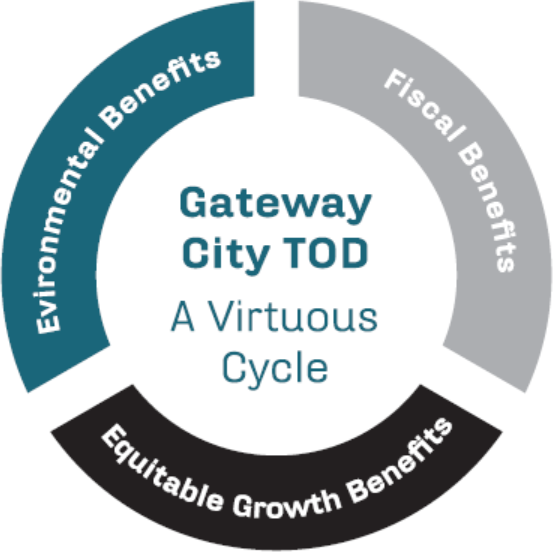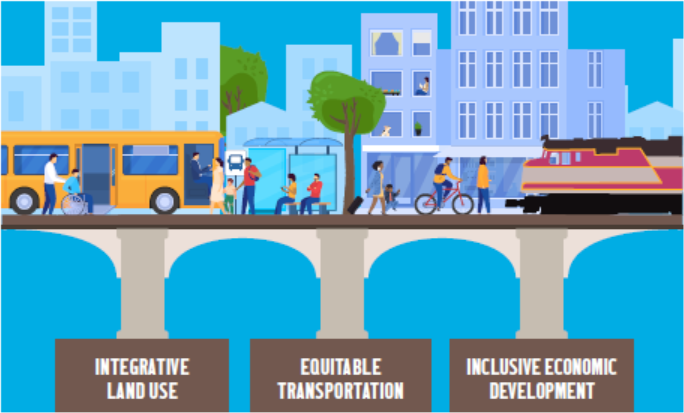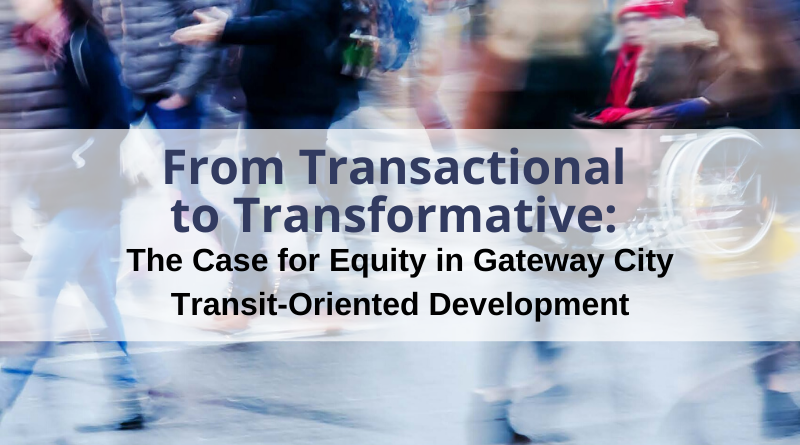From Transactional to Transformative: The Case for Equity in Gateway City Transit-Oriented Development. (May 2020)
Tracy A. Corley, PhD, Elizabeth Haney, Ben Forman, and Catherine Tumber, PhD.
Transit-oriented development (TOD) is a powerful tool in local and regional transformation, but without equity-centered policies and practice, TOD can bring gentrification, displacement, and socio-economic exclusion in neighborhoods that need the most support. In May 2020, authors Tracey Corley, Elizabeth Haney, Ben Forman, and Catherine Tumber of the MassInc Gateway Cities Innovation Institute released a report detailing the importance of Transformative TOD (TTOD)—a framework that intentionally “leverages equitable environmental, fiscal, and growth benefits” of developing property near transit stations. The authors set the concept in opposition to transactional TOD, which involves “little or no effort to improve the quality of life or advance the economic prospects of people and businesses in the district and surrounding neighborhoods.” As the impact of the global coronavirus pandemic amplifies the inequities in our neighborhoods, Corley notes that the road towards recovery will not be easy, but that initiatives to “build thriving, robust communities and economies” are essential to post-coronavirus recovery.
Without intentional equity-centered policies and practices, transit-oriented development can further exacerbate uneven growth in cities. To truly transform American cities and towns, local leaders, policymakers, and residents need to tackle inequity in all its dimensions.
The 62-page report expands on findings from the group’s 2018 study and encourages leaders and policymakers to intentionally use transit-oriented development to address equity issues and uneven urban growth in Gateway Cities. However, these findings can be applied effectively to regions with smaller cities surrounding a large metropolitan area. The authors highlight four reasons to advocate for transformative transit-oriented development (TTOD), three pillars or tools needed to achieve TTOD, and strategies for integrated local planning.
Equity and Transformative TOD

The report focuses on transformative transit-oriented development and the importance of creating a “virtuous cycle of benefits” that is often lacking in transactional TOD. Without equity backing neighborhood transformation, transactional TOD turns neighborhoods and cities into bedroom communities with few social and cultural activities, little to no job opportunities, and unaffordable housing. The report describes four issues that can be addressed by TTOD:
- Demographic changes
- Gentrification fears
- Socioeconomic exclusion
- Geographic disparities
According to the authors, equitable TOD helps cities adopt more efficient and flexible uses which cater to the community needs as neighborhood populations change, age, and grow. Transformative TOD also provides tools, programs, spaces, and places that address the concerns of a broader range of socioeconomic classes, bridging the wealth gap and giving underserved communities a leg-up for economic mobility. Revitalization and development under TTOD protect lower-income residents from displacement while drawing in new residents and businesses. TTOD also opens up more avenues of holistic regional development. This process encourages communities to invest in their own built environment and leverage their own assets and resources for economic development, and not just rely upon proximity to larger urban areas.
Three Pillars of Equity for Transformative TOD
To achieve transformative TOD, state and local policymakers need to create an environment that supports transit-oriented development and revitalization without displacing existing residents and businesses, widening socioeconomic gaps, and hindering access to jobs, education, and services. The report identifies three policy pillars that can be used as equity tools in TOD: integrative land use, equitable transportation, and inclusive economic development.

Integrative land use planning and implementation relies upon the expansion of investment areas in cities through inclusive zoning policies and practices, supporting more intensive housing development, and planning for more culturally, racially, and economically diverse communities. Mixed-use and integrative design allows for more land value capture in transit-oriented communities.
Equitable transportation makes use of multi-modal systems that enhance geographic connectivity, minimize negative environmental and public health impacts, and reduce economic barriers to mobility. By supporting non-automotive transportation options, such as public transit and active transportation infrastructure, cities can create safe, reliable, and affordable transportation networks that meet people’s mobility needs regardless of age, ability, class, race, or status. The report suggests consideration of the integration of public and active transport systems in land use planning and practices. By maximizing regional connectivity and focusing on providing frequent, affordable, and reliable public transit, agencies will encourage more ridership.
Economic development helps generate market conditions conducive to the transformation of a region’s quality of life. Regional cities often possess fewer resources and less service capacity than large metropolitan areas but face similar cost burdens. By encouraging equitable and inclusive economic development, these communities are better able to participate in wealth-building, skill-development, and educational activities. Beyond providing more access to employment, economic development strategies must focus on providing pathways to sustainable livelihood and bridging gaps in wealth, mobility, and education that have developed over generations of exclusion and injustice. The report encourages cities to invest in anchor institutions that support local talent and organizations that are vested in the success of the local community. Furthermore, cities with strong small business ecosystems support wealth-building and local economic stability.
Joint Local Planning
Finally, the report identifies a key component in revitalizing and transforming transit-oriented communities. Equity and inclusive development cannot be sustained in a piecemeal fashion, but instead require collaboration and cooperation among geographies and constituencies to ensure true and lasting transformation. Joint local planning uses all three policy pillars—integrative land uses, equitable transportation, and inclusive economic development—and empowers regional agencies, city staff, private and non-profit organizations, and community members to think through strategies on various levels of government to achieve their desired outcomes without causing adverse effects to members of the community.

